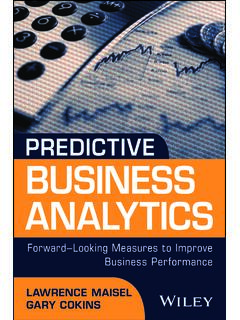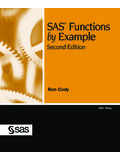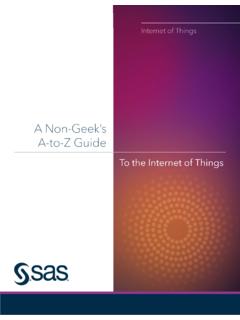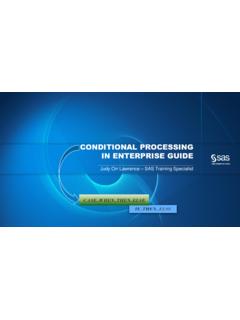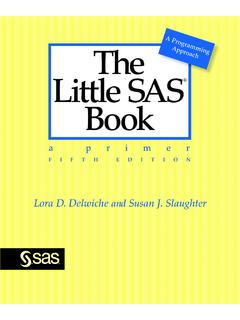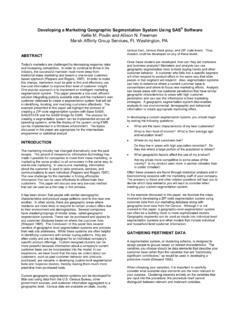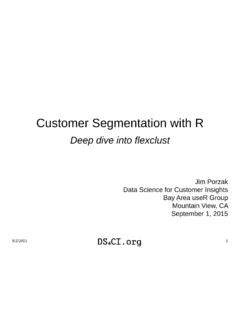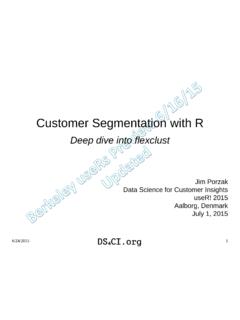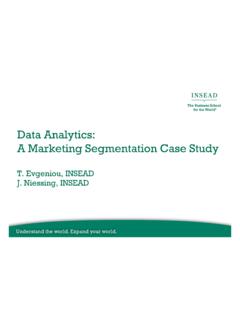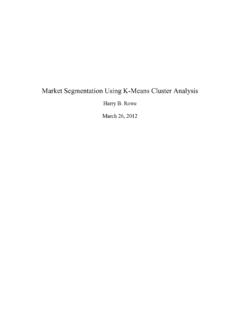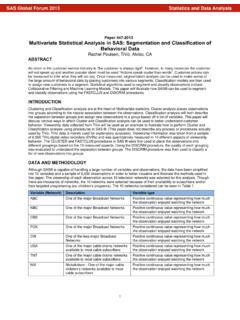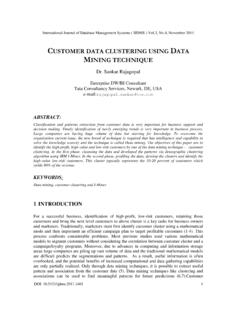Transcription of Retail Customer Segmentation - SAS
1 Retail Customer Segmentation using SASA pril 2014 Calgary SAS Users Group meetingJenny ChenData Science, LoyaltyOneAgenda Overview Applications Objectives Types of Segmentation A Real Example with SAS Code Further Reading Overview Customer Segmentation is the practice of classifying your customers into distinct groups based on the similarities they share with respect to any characteristics you deem relevant to your business Key components in developing proper, actionable Segmentation Understand business needs and objectivesCustomer satisfactionShare of walletMarket share Available Customer informationDemographic Geographic BehavioralAttitudinalApplicationsExample sCustomer Investment Allocation Determine segment s current and potential profitability Define differentiated value proposition by segmentCustomer Relationship Management Better meet Customer needs, improve Customer satisfaction Develop Customer loyalty to your brand Improve retention strategyTailor Marketing Program Build relevant campaign.
2 Communication Optimize marketing channel mixGuide New Product Development Product preference Potential targeting audienceGuide Product, Service Pricing Price sensitivity Stimulate Customer many moreApplicationsObjectivesCreate RelevancyChange BehaviorImprove Financials Better defined target universe Right offer, communication, channel, time for right customers Personalized experience between clients and their customers Higher response rates Combat attrition of high profit customers Grooming lower current value high potential customers Identify cross-sell & up-sell opportunities by Customer Measureable improvement in sales, traffic, revenue More cost effective campaign deployment and ROI Opportunity identification by category, department, store, enables business to increase profitability while positively addressing Customer needsSegmentation Type Demographic, geographic Behavior, attitudinal Life stage.
3 Life styleData sourceApproach Business rules- Profit ranking- RFM (Recency, Frequency, Monetary) Supervised clustering- Decision tree Unsupervised clustering- K-means clusteringOccasionalUsing unsupervised clustering Segmentation for a grocery chain which would like better product assortment for its high profitable customersPotential InputsBasketTimeLocationValue Basket Size Visit Frequency Spend by category Type of category Brand spend ( private label) Time of day Day of week Store format Area population densityPromotions % bought on targeted promotion % bought from flyerClustering approachDeal Seeking MomKey Differentiators Full store shop High avg.
4 Basket size / # trips High spend categories- Fresh produce- Organic food- Multipack juice, snack High % purchased on promotion Rewards seekerA Behavior Based Segmentation ExampleSegmentation Building Process I Identify high profitable Customer groups Improve product assortment for them Design relevant, effective marketing campaigns for them Quantify campaign measurementsDefine business objectiveGather information Customer transactional data Promotional data Client store, department, category merchandising hierarchyAlign with client on project scope Business Objectives Data Sources Methodology Measurement planSegmentation Building Process II Data merge purge, data cleaning, dealing with missing Convert all attributes to numeric metrics, cap outliers Standardize all metrics/variables Standardization enables each metric have similar contribution to the future cluster buildingData preparationPROC STDIZEDATA= OUT= OUTSTAT= (WHERE=(_TYPE_ IN ('LOCATION', 'SCALE')));VAR RUN.
5 Segmentation Building Process III Check descriptive statistics, correlation among all potential variables Use principle component, factor analysis (PROC PRINCOMP, PROC FACTOR) Use the Variable Clustering node in SAS Enterprise Miner to create variable cluster constellation plot and variable cluster tree diagramData exploration, variable reductionMeasure similarity among customers Using Euclidean distance - this measures the distance between 2 points in multi-dimensional space A very common method of unsupervised clustering with large data using Euclidean distance is K-means clusteringSegmentation Building Process IVK-means clustering Using the distances to group customers into K clusters where each Customer is with the nearest centroid The centroid is calculated as the multi-dimensional set of the means of the variables used for the particular cluster Pre-determine a range of number of clusters.
6 Use bottom-up approach Test the FASTCLUS procedure repeatedly using different starting points and different number of clusters until we obtain stabilized centroids and desired distance between clustersPROC FASTCLUSDATA= MAXCLUSTERS=29 OUT= OUTSEED= OUTSTAT= REPLACE=RANDOM RANDOM=187413849 CONVERGE= ;VAR RUN;Output of K-means ClusteringCluster MeanClusterVar1 Var2 Var3 Var4 Var5 Var6 Var7 Var8 Var91( )( )( )( )( ) ( ) ( ) ( )( )3( )( )( )( )( )( )( ) 4( )( )( )( )( )( )( )( )( )5( ) ( )( ) ( )( ).
7 29( )( )( )( )( )( )( ) Statistics for VariablesVariableRSQ/(1-RSQ) ..Var Centroids info Statistics for variable comparison and further variable reduction RSQ/(1-RSQ) is the ratio of between cluster variance to within cluster variance Get client s buy-in for the final list of variables for cluster buildingSegmentation Building Process VBottom-up approachPROC CLUSTERDATA= METHOD=AVE OUTTREE=TREE;VAR RUN;PROC TREEDATA=TREE;RUN; Flexible with how many clusters to choose initially Aggregate clusters up afterwards using hierarchy clustering PROC CLUSTER Create a tree diagram for clusters using PROC TREE Choose proper distance to fit into client s request of final number of segments and distribution of segmentsBottom-up ApproachTree diagram to illustrate the arrangement of the clusters Detailed distinctive clustersSeg1 Seg2 Seg3 Seg4 Segmentation Building Process VI Test campaigns with segments strategy Measure campaign results by segments Validation segments with market research surveyValidate
8 Segmentation effectivenessReview, iterate, deploy again Update segments regularly Monitor the migration of segments Gather feedback, campaign response results Maintain and improve the processSegments profiling Using cluster building variables to profile the segments Using additional data source to profile them as well Paint a clear picture of your segmentsPros and Cons of K-means ClusteringPros Flexible with fewer assumptions about your Customer population Can incorporate many relevant metrics Provide more comprehensive, diverse segments Simple algorithm fast to run with large dataset Prove to work well for behavioral targetingCons Purely data driven Pre-specify number of clusters or the minimum distance between clusters Time consuming to maintain: for example, certain metrics used to build the clusters were changing overtime dramatically May have difficulty to explain the concept to your marketing clientsQuestion or video about LoyaltyOne: Enriching Relationships website 2014 LoyaltyOne, Inc.
9 All rights reserved. No part of this material may be produced in any form without the written permission of the owner. No representation or warranty of any kind is made with respect to the content hereof and no liability is assumed for errors contained herein or for incidental or consequential damages in connection with the furnishing, performance or use of this publication or its contents.
